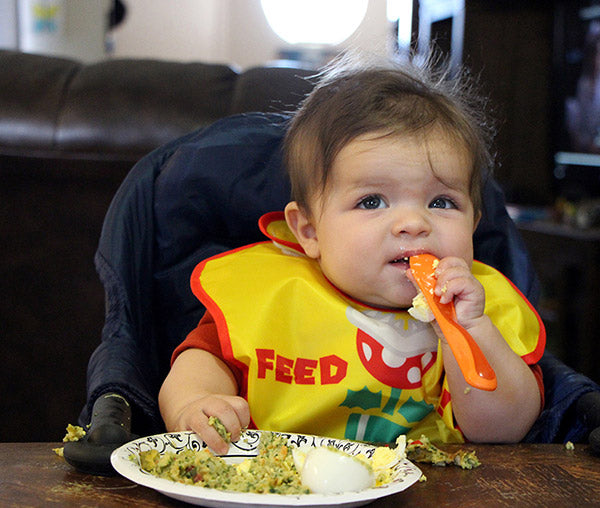
October 30, 2020
Tips to Introduce Baby Purees
During our six-month pediatrician visit, the doctor gave us the green light to start giving our daughter solid foods. She armed us with brief anecdotal advice and a sheet of paper with feeding guidelines, then sent us out the door with a smile of encouragement. We drove to the grocery store very excited to buy supplies to feed our girl “real food” for the first time.
Unfortunately, I felt my enthusiasm drain as soon as I stepped foot in the baby food aisle. I was instantly overwhelmed by the baby purees. There were so many choices, “stages” and brand names. I called my friend and fellow mom, desperate for some advice. Where was I supposed to start?
Per her suggestion, I left the store armed with an assortment of Gerber First Foods baby purees flavors. “She’ll love sweet potatoes!” I thought, enthusiasm returning for the task ahead.
(Movie trailer narrator voice: she did not, in fact, love sweet potatoes.)

After a few days of trying to show her the glorious world of tasting new foods, my kid just wasn’t buying it. She made faces, spit out the vegetable purees, rejected the spoon and gagged whenever she accidentally let some of the food into her mouth. She did slightly better with fruit purees, but not much. This drama honestly went on for weeks. I no longer looked forward to meal times, I dreaded them. Maybe, I thought, she could live on formula for the rest of her life.
It turns out, I wasn’t alone. I started asking around and got a lot of advice from my friends, family members, and the Internet. Now that she’s nearly 13 months old, my daughter has a healthy appetite and is much better about trying and actually swallowing various solid foods. Below I’m sharing some of the tips to help children that struggle with baby purees.
Introduce different textures.
While fruits, vegetables, and proteins obviously have the most nutritional value, don’t rule out introducing other textures like puffs. Note: Make sure your baby is able to sit independently before offering finger foods. Alternating between smooth and more textured food is a great way to get your baby used to these differences, and also may prevent boredom or puree burnout. Another positive? Puffs feel really good on the gums of teething babes.
Combine flavors.
It’s really important to us that our daughter learns to truly enjoy the taste of vegetables. However, it’s a marathon, not a sprint. My mom gently suggested buying the purees that combine fruit like pears with vegetables like peas and zucchini (this is one of our favorites). While that might not sound appealing to our adult palettes, the sweetness keeps babies coming back for more, helping her get the nutrition she needs and practice the mechanics of eating and swallowing.
Once your baby gets the hang of it, our pediatrician recommends backing off the fruit/veggie combo and introducing the individual flavors once again.

Try the pouches.
Speaking of pouches… I started off using little disposable cups and glass jars of baby food. After a month or so, I bought a few pouches to try. It turns out she loved taking “sips” of the baby purees from the pouch instead of being force-fed with a spoon. It was also a lot less messy and easier on the go. If she was in a mood and would even refuse the pouch when I offered it, I let her hold it with supervision. I think giving her the opportunity to take some control of the situation was appealing to her.
Consider baby-led weaning.
If all of these efforts aren’t producing any results, look into baby-led weaning. I stumbled upon this concept by accident after my daughter expressed a clear interest in the foods I was eating. For example, while chowing down on a turkey sandwich, I could see the want and need in her eyes from across the room. So, I let her try a very tiny piece of turkey. To my surprise and delight, she LOVED it, way more than she’d ever loved any puree.
Baby-led weaning isn’t for everyone, but I certainly found my child much preferred trying safe, bite-sized amounts of “proper food,” over the baby purees she was offered. For some ideas, consider trying cottage cheese, small pieces of turkey, thinly-sliced steamed green beans, roasted sweet potatoes cut into cubes, and banana cut into small chunks. Always make sure the bites are small enough so your baby won’t choke.
If your baby is struggling to transition to solids, don’t worry. Some babies are ready to start eating as early as 4 months old, while others need to wait until 9 months or older. All you can do is be patient and try different things to figure out what works for you and your child. No matter what happens in this journey, know that you’re doing a great job.